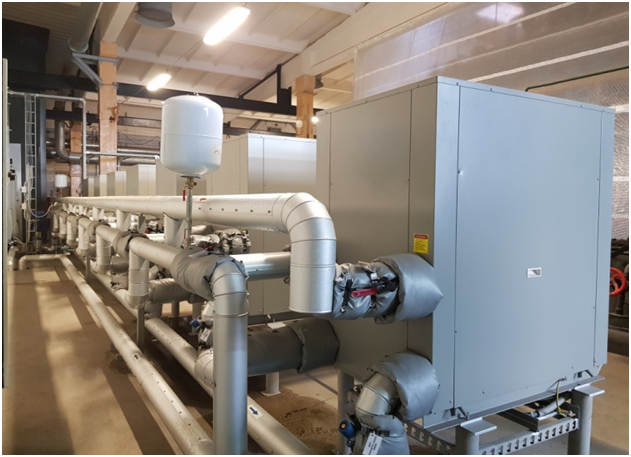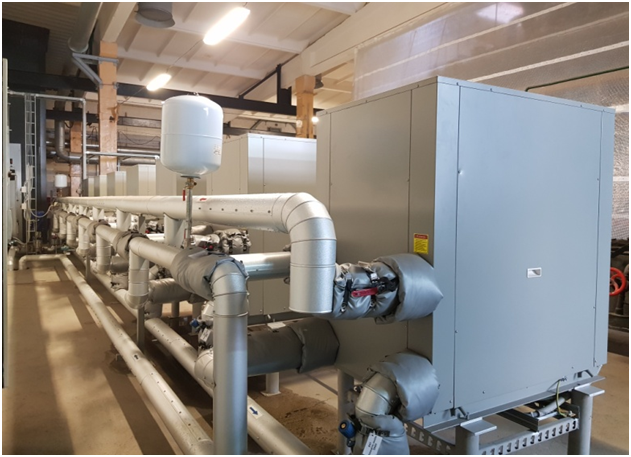AB „Šiaulių energija“
- Category: Our project

Šiauliai, Lietuva
2020
Increasing the efficiency of condensing economizers using heat pumps
It is very important for any heat supplier to use equipment and resources as efficiently as possible so that the cost of heat produced is as low as possible (more competitive).
More recently, flue gas condensing economizers have been used to increase the efficiency of boiler houses. Today we want to bring to your attention solutions that allow you to increase the efficiency of condensing economizers using heat pumps.
- Use of condensate energy (on the example of the project AB „Šiaulių energija“)
Today, excess condensate that forms in the economizer is usually sent to the sewer. The temperature of the condensate depends on temperature of the returning network water and ranges from 55°С to 35°С. In turn, the volume of condensate depends on the moisture content of the fuel, for example, at a constant load of a woodchip boiler with a capacity of 40.39 MW, the volume of condensate varies from 3 to 20 m3/h. In order to use the thermal energy of such a volume of condensate, in 2021 AB „Šiaulių energija“ introduced a condensate heat recovery system with compressor heat pumps.
AB „Šiaulių energija“ set rather strict requirements for the system:
- The COP of the system (the ratio between the amount of generated heat energy (kWh) and the electrical energy (kWh) required to operate the entire heat pump system) must be greater than or equal to 4 at a condensate flow rate of 10 m3/h at a temperature of 48°C (±3°С) and return network water temperature 45°С (±2°С). According to the requirements of the contract, the achieved COP is calculated taking into account all consumers of the system's electricity: heat pumps, circulation and condensate pumps, electric drives, heat meters, controller, etc. The controller calculates the COP of the system according to data received from the heat and electricity meters.
- The temperature of the chilled condensate should not exceed 15°C (±2°C) at a condensate flow rate of 10 m3/h and 18°C (±2°C) at 15 m3/h. It was necessary to ensure such a temperature due to the fact that the customer sends the cooled condensate to the chemical water treatment system with reverse osmosis.
Project implementation results:
- The designed and installed plant confirmed the parameters that were included in the project.
- With a condensate flow rate of 10 m3/h and temperature of 40-43°С, consuming 100 kWh of electricity, this unit generates from 420 to 460 kW of thermal energy per hour.
- COP ranges from 4.05 to 4.2 even with a condensate volume of 18 m3/h (we are sure that as the temperature of the condensate increases, the COP and the amount of heat produced will increase too).
- With an increase in the volume of condensate to 20 m3/h, the temperature increased to 21°С.
Recommendations for the implementation of similar projects:
- Since condensate is most often discharged into the sewer, its volumes are not recorded very accurately, that is, there are no accurate data on the flow rate per hour, and this is very important when designing a system;
- The customer sent all the water of the steam boiler sample cooling system to the installation - this is very correct and businesslike, but it reduces the COP, since its temperature is about 30-32°С. When the implemented installation was operating only with sample cooling water, without condensate, the COP decreased to 3.8-3.9;
- Since pumps are mounted on the condensate line that was directed into the sewer, it is possible for condensate to overflow from the storage tanks in the event of a power failure. It is desirable to provide a system that works without electricity consumption, which, in the event of a pump stop, will not allow condensate overflow.
- Decrease in water temperature at the inlet to the economizer.
The efficiency of flue gas economizers is highly dependent on the temperature of the returning heating water. Due to the increase in the temperature of the return network water in summer, the efficiency of condensing economizers deteriorates significantly.
For heat networks in Mazeikiai, we considered two options for improving efficiency with the help of heat pumps. The option to install an absorption heat pump was abandoned due to the lack of a high temperature heat source. The only possible option was considered to be with compressor heat pumps..
According to our calculations, it turned out that when implementing a system with compressor heat pumps, the COP of which will be from 4 to 5 (taking into account all consumers of the system's electricity), the Customer can receive an additional up to 1.2 MW/h of heat from heat pumps in the summer, while the heat generation at the economizer will also increase from 15 to 25% (it is difficult for us to calculate more precisely on this type of economizer).
Since the heating networks of Mazeikiai do not have an electrostatic filter, and the condensate after the economizer is polluted, for this case we have a solution with a tubular heat exchanger with special self-cleaning tubes. Such a heat exchanger has been operating at Zarasai boiler house for more than 5 years and has proven itself perfectly.
We will be happy to offer you our solutions (design, construction, commissioning).





